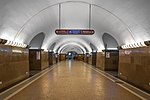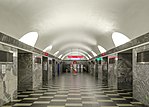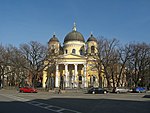Statue of Lenin at Finland Station

The statue of Lenin at Finland Station in Saint Petersburg is one of the most famous statues of Vladimir Lenin in Russia. Erected in 1926, it was one of the first large-scale statues of Lenin, being completed within three years of his death. It depicts the man making a speech from atop an armoured car, soon after his 1917 arrival at the station from exile abroad. It was designed in an early constructivist style by sculptor Sergei A. Evseev and architects Vladimir Shchuko and Vladimir Helfreich. The style and pose of the statue were imitated by later works. The statue is one of few in Saint Petersburg that survived after the fall of the Soviet Union. It was damaged in a 2009 bomb attack but has since been repaired.
Excerpt from the Wikipedia article Statue of Lenin at Finland Station (License: CC BY-SA 3.0, Authors, Images).Statue of Lenin at Finland Station
Арсенальная набережная, Saint Petersburg Vyborg Side (Финляндский округ)
Geographical coordinates (GPS) Address Nearby Places Show on map
Geographical coordinates (GPS)
| Latitude | Longitude |
|---|---|
| N 59.95404 ° | E 30.35542 ° |
Address
Ленин на броневике
Арсенальная набережная
195009 Saint Petersburg, Vyborg Side (Финляндский округ)
Saint Petersburg, Russia
Open on Google Maps










